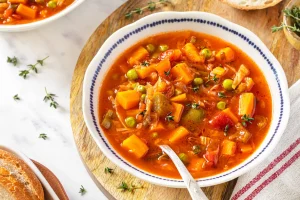A steaming bowl of soup has the power to ground oneself instantly. The familiar flavors, aroma, and warmth do more than just satisfy your hunger; they envelop you in a hug. Comforting soups are about more than just food; they’re about nostalgia, memories, and the warm comfort of home.
Whether you’re cooking for your family, yourself, or simply need a little warmth on a chilly evening, we’ll explore how to make soups that foster connection and comfort in this blog.
What Makes a Soup Truly “Comforting”?
A comforting soup has less to do with complexity and more to do with feeling. It’s built on flavors that remind you of safety and home.
Warmth and Familiarity
- Comforting soups use ingredients you know, onions, garlic, carrots, and herbs.
- They’re often slow-cooked, giving your kitchen that irresistible, cozy aroma.
- The act of stirring a simmering pot connects you with the moment, like therapy in a spoon.
The Power of a Good Base
- Every great soup starts with a strong foundation: broth or stock.
- Homemade stock (from bones, vegetables, or herbs) gives a depth of flavor that feels authentic.
- Store-bought options can work fine; just look for low-sodium versions so you can season it your way.
- A rich, flavorful base is what separates a good soup from a truly comforting one.
Aromatics – The Soul of Flavor
- Before anything else goes in the pot, start with aromatics, onions, celery, garlic, and herbs.
- Sautéing them in butter or olive oil helps release their natural sweetness.
- The smell of this step alone can make your kitchen feel like home.
Texture and Balance
- Comfort isn’t just in taste, it’s in texture. Some like a creamy, smooth soup; others prefer chunky and hearty.
- Creamy soups (like potato or tomato bisque) soothe and calm.
- Chunky soups (like chicken noodle or lentil stew) feel like a meal in a bowl.
The balance of salt, fat, acid, and sweetness (the “FASS” rule) keeps flavors comforting but lively.
Stocking Your Pantry for Comfort
Making homemade soup doesn’t mean starting from scratch every time. With a few essentials, you can whip up a comforting bowl anytime.
Core Pantry Items
- Broth or stock (chicken, vegetable, or beef).
- Onions, garlic, and shallots.
- Herbs (bay leaf, thyme, rosemary, parsley).
- Root vegetables (carrots, potatoes, sweet potatoes).
- Canned beans or tomatoes.
- Frozen peas or spinach.
- Olive oil or butter.
- Salt, pepper, and vinegar.
These items are the backbone of comfort food. They make it easy to pull together something heartwarming in less than an hour.
Prep Tips for Easier Cooking
- Chop aromatics in batches and store them in the freezer.
- Save vegetable scraps to make stock.
- Cook once, enjoy twice: soup always tastes better the next day.
The Step-by-Step Formula for Comforting Soup
If you can remember this simple rhythm, you can make any soup comforting and delicious.
Sauté Aromatics
- Start with butter or olive oil. Add onions, garlic, carrots, and celery.
- Cook slowly until they soften and release their fragrance.
- This step builds your foundation of flavor.
Add Main Ingredients
- Add your key ingredients, vegetables, lentils, chicken, or beans.
- You can deglaze the pot with a splash of broth or wine to lift up the browned bits at the bottom.
Pour in the Broth and Simmer
- This is where the magic happens.
- Bring everything to a gentle boil, then reduce to a simmer.
- Let the flavors blend for at least 20–30 minutes.
Adjust Texture and Seasoning
Once your ingredients are tender:
- For creamy soups, blend all or part of the mixture.
- For chunky soups, leave as is or mash slightly for body.
- Taste and adjust with salt, pepper, lemon juice, or herbs.
Finish and Serve
Add finishing touches that make your soup shine:
- A drizzle of olive oil.
- A handful of fresh herbs.
- A sprinkle of cheese.
- Warm, crusty bread on the side.
Types of Comforting Soups
There’s a comforting soup for every mood and moment. Here are some types that always bring warmth and familiarity:
Classic Brothy Soups
- Chicken noodle, vegetable, or miso soup.
- Light, soothing, and perfect when you need something easy on the stomach.

Creamy and Smooth Soups
- Butternut squash, tomato basil, or potato leek.
- These soups are velvety, rich, and indulgent without being heavy.

Hearty and Chunky Soups
- Lentil, bean, or beef stew.
- Packed with texture and flavor, ideal for cold evenings or post-school comfort.

Global Comfort Soups
Sometimes comfort comes from exploring new flavors that still feel familiar.
- Thai coconut soup – creamy with a hint of spice.
- Italian minestrone – hearty and colorful.
- Middle Eastern lentil soup – warm spices with a lemony finish.

Seasonal Soups
- Winter: Creamy potato or mushroom soup.
- Spring: Asparagus or pea soup.
- Summer: Light tomato or zucchini soup.
- Autumn: Butternut squash or pumpkin soup.
Presentation and Atmosphere
Soup isn’t just about flavor; it’s an experience. How you serve it can turn a simple bowl into something special.
Tips to Elevate Your Serving
- Warm your bowls before serving.
- Add a topping: fresh herbs, croutons, or a drizzle of cream.
- Serve with sides like grilled cheese, toast, or garlic bread.
- Set the mood: dim lights, cozy blanket, maybe your favorite show or music.
The goal? Create a space that feels like home, because comfort food is as much about emotion as it is about taste.
Storing and Freezing Comfort
One of the best parts about making soup is having leftovers.
Storage Tips
- Cool the soup completely before refrigerating.
- Store in airtight containers for up to 4 days.
- Freeze in individual portions for quick comfort later.
Reheating Tips
- Reheat gently over low heat.
- Add a splash of fresh broth or water to refresh the texture.
- Top with herbs or a dash of lemon to brighten flavors.
Common Soup Troubles
Even the coziest cook can hit a bump. Here’s how to fix common soup problems:
- Too bland? Add salt, vinegar, or lemon juice to lift flavor.
- Too thick? Stir in a bit of broth or water.
- Too thin? Simmer uncovered to reduce or blend a few vegetables.
- Too salty? Add a peeled potato, it will absorb excess salt.
Remember, comforting soups don’t have to be perfect. They just have to feel right.
Bringing It All Together
Creating comforting soups that feel like home is more than following a recipe; it’s about intuition, heart, and memories. It’s stirring the pot while the house fills with warmth. It’s the first spoonful on a cold day that makes you sigh with contentment.
You don’t need fancy ingredients or culinary training. All you need is:
- A pot.
- A few simple ingredients.
- And a little bit of love.
So grab your favorite bowl, ladle some comfort, and let your kitchen smell like home again.
Don’t Miss Out Our Blog Post: Balancing Health and Taste How to Enjoy Every Meal While Staying Nutritious


